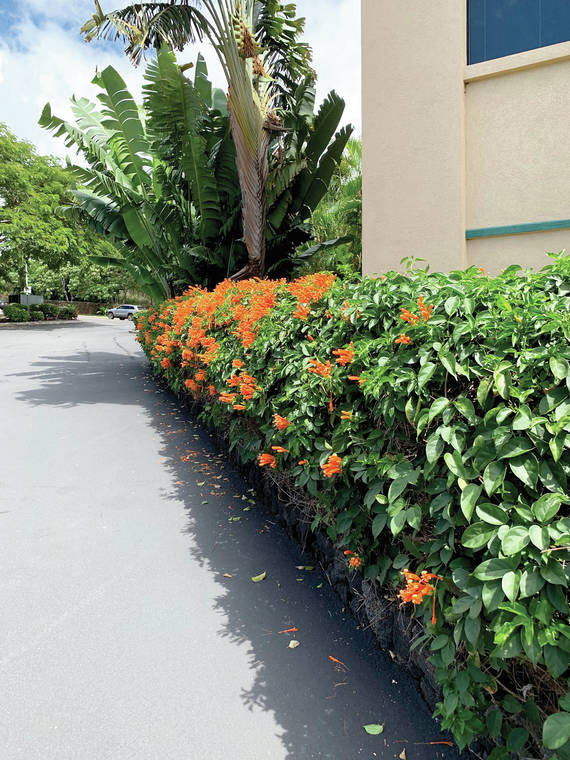Good fences make good neighbors goes the old saying, and maybe in the old days it was the case. Stone walls are traditional and impressive, but expensive. Today, we have so many choices that an unattractive fence might create all kinds of neighbor problems depending on type of material used.
Take the case of the two fellows who got into a feud because the chain link fence one put up made the other feel like he was in the County Prison. Another example was the neighbor who used running bamboo for the hedge. It wasn’t long before the bamboo spread into the neighbor’s lawn and created a mini grove. Clumping bamboo that won’t run rampant would have been the proper choice. A third example is the guy who planted a bougainvillea hedge and then decided to go on a trip around the world for a year. Bougainvillea makes a great hedge or screen, but when left unattended, it can get a bit wild.
Bougainvilleas are interesting plants from South America. They can be kept as beautiful hedges, topiaries or allowed to become colorful vines climbing high into a large tree. Some of the best uses are as screening plants along roads to hide unsightly industrial views like those used at the entrance to the Kona airport. Bougainvilleas may also be used on wide median strips like the entrance to Kailua. Bougainvillea plants are drought tolerant and flower best in dry sunny climates. Visualize the drive from the Kona Airport to Kailua as an 8-mile riot of color. It would be far less expensive to maintain than grass that takes constant mowing and is usually full of weeds. Probably the main negative is that the plants are often quite thorny. When used in a median strip landscape this is an advantage because it keeps pedestrians and cars from crossing traffic.
Screening on smaller home sized landscape may require fences to keep animals or children in bounds. However, chain link, concrete block and many other fence and wall materials do look kind of harsh and unsightly. They just don’t give that luxurious tropical feeling. So here’s where vines make ideal companions.
Concrete and chain link make ideal supports for the many types we have available like the Flame Vine, Passion Flower, Jade Vine, Kuhio Vine, Potato Vine, Creeping Fig and many others.
Vines serve many purposes for the gardener. Take the one that produces egg-like gourds — it’s ideal for the practical joker. Then there is a vine that specializes in dishcloth production, called the Luffa.
Bird lovers like Flame Vine because they attract birds. Other lovers like the privacy vines give them when sitting on the lanai.
Many folks like vines because they harbor chameleons, anoles and geckos. Many songbirds like vines because they are good nesting locations. And, last but not least, vines are fine because of their attractiveness both in foliage and flowers. Vines lend contrast and character to landscape plantings. They accentuate architectural lines, especially the closely clinging species. Vines are adept at introducing color, form and texture onto otherwise uninteresting objects, fences, shrubs or trees.
Many gardeners say that vines are the best to give their homes an air of tropical living by using them to cover passageways or to form patio walls. Ornamental vines, as a group, are well adapted to a wide range of soils. Most of them thrive in sand, clay, or rock land, provided plant food and moisture are adequate.
Soil preparation is most important in planting project. Time spent in improving the soil will insure that you will produce vigorous plants and possibly have trouble free care later.
To get a project underway, spread about 4 inches of compost, peat, leaf mold, or decomposed manure over the area where the vines will be planted. As a topping, sprinkle the area with fertilizer, and then mix the organic material and soil with a spade. In selecting a location for vines, give them plenty of room.
Before planting vines close to a tree, remove the tree roots in the immediate area, but not too many roots, or the tree may die. Tree like Ohia will not stand much root snipping. If you are using a tree to support the vines, don’t let it completely cover the tree or it may be harmful. Some trees like citrus do not do well when competing with vines.
The soil at the base of masonry construction often contains construction debris, so remove the contaminated soil to a depth of 18 inches. Replace it with a good soil taken from another location.
The planting season for vines is any time the notion strikes you, provided the vines are small, thrifty, container grown plants. In planting, dig a hole that is larger than the root ball. If the plant is in a container, carefully remove the plant without disturbing the roots and settle it in the hole at the same depth it was in the container. Partially fill in around the plant with soil. Water thoroughly. Finish filling the hole and water again.
When two or more vines growing side by side become hopelessly entwined, the effect can indeed be spectacular. Vines can complement one another in several different ways. An evergreen vine hides the bareness of a deciduous vine. Vines blooming at different seasons extend the flowering season. Vines blooming at the same time can display handsome color contrasts or blends.
There are dozens of tropical vines available here on Hawaii Island. The Bengal clock vine, with its sky blue flowers, the garlic vine, the exotic passionflower vines, confederate jasmine and philodendrons are just a few. Check with our local nurseries and get acquainted with what’s available.






